From my Diaries in the 1970's and 80's...... 1
It all started in Brisbane [Australia] when I stumbled across the book entitled Pack and Rifle by Phillip Holden, the book described the life of a New Zealand deer culler employed by the New Zealand forest service. The author went on to describe his day to day life being paid to hunt deer for a living. In this day and age [the year incidentally was 1974] it astounded me to say the least. I’d no sooner read the book, than I was myself applying for a position as a hunter . The much-awaited reply was dropped through my letterbox, in the suburb of Kangaroo point . With regret [the letter stated] Mr. Garnett, without first interviewing you, it’s not our policy etc. etc. etc. The letter being signed, Ian Logan P. I. C. ,Noxious Animal Control N.Z.F.S. Palmerston North. To cut a long story short, I was face to face with Mr. Logan within the week! The resultant chat had me cooling my heels for a week before journeying up to a very small town in the central Nth. Island called Mangaweka. Penetrating further from Mangaweka alongside the Kawatau river toward the ranges and you eventually arrive at the base camp for the deer hunting operations, which is called Kawatau.
It was here then, that the field officer for this area, Henry Dorrian took me in the winter of 74. I met Henry outside the PO in central Mangaweka as arranged. After a few pleasantries I was told to stow my gear in the back of the Toyota. He had a few things to attend to and said he would not be too long. “Get yourself a beer”, and I will call back for you in half an hour. I’d had a few beers before I caught sight of Henry again. In fact there were two Henry's.
Kawatau base camp was sitting hard up against the bush edge. I remember my thoughts as we arrived at the base. Am I actually in Deer country?. I kept repeating the question to my self, already knowing the answer, cos the answer was all around me, spectacular mountains stretching for ever in most directions.....snow capped too. The awe in my expression must have been obvious for all to see.
I was introduced to the lads who seemed a great bunch. Henry stayed the rest of the day. In fact, to help settle me in, the night also. The next day I was to be put to work as a track cutter. This was the prime job of the Ruahine hunters in winter. It entailed a six-day week with Sunday off. The Sunday [I had decided ]was the day I was to learn the art of deer hunting. I gleaned much information and advice from my work mates during the coming weeks. And put them into practice on the weekends. Photo point ridge was the area that yielded my first deer. High above the Kawatau river in mid winter, late morning, just a little above the deer enclosure on photo point ridge, saw me slowing to a halt to examine fresh sign in the form of two sets of deer slots, and fresh droppings. Making as little noise as possible, I followed the well-marked route of the deer. Through the sparse trees above me I could see the snow covered tussock. The breeze thankfully, was blowing directly into my face. I had stalked carefully through two shallow gullies, when my nostrils picked up that unmistakable smell of deer! Moving even more carefully than ever now. Barely moving I snuck over the slight rise that was both a mixture of snow grass and beech, to be confronted by two heavily bodied stags. Facing quarter away, but looking back over their shoulders, their eyes locked on to mine. Just for the most fleeting moment, we stood face to face. Then with a heavy grunt they forged ahead, one just trailing the other over the lip into the next gully. Somehow I reacted at one with their movements, and as the second stag disappeared over the lip, the 30/30 reticule of my 4x Pecar scope picked up the stag just behind the shoulder. Swept forward and at the same time I squeezed the trigger of the Mauser 270 cal.rifle. After the blast, and recovering from the recoil, I heard much crashing of a big body forging itself through scrub. Silently praying it was only one body escaping, but denying myself the euphoria, of believing I had finally nailed my very first deer. Unable to contain myself any longer, I sprinted forward, almost tripping over the fallen beast. I must admit to quite a few emotions right then, including a deep sense of regret and remorse. The head turned out to be a reasonable ten pointer. It was promptly chopped off and I’m afraid, chop being the operative word, no hint of meat being taken either! This was pointed out in no uncertain terms by Henry Dorrian later that evening. Making my way down through the bush, with the Kawatau River almost in view, I stopped for a breather. Looking across onto a face of crown fern, I was surprised to see a neck and head of a red deer appear as if by magic [hind] two shots later, and the two hinds had completely disappeared. I searched high and low, but to no avail. It remains as much a mystery to me now as it was to me then.
Before crossing the river that day, I was to lose my puma ‘rabbit’ sheath knife, but it was still a proud and tired track cutter that returned, to the Kawatau base camp that winter evening.
It all started in Brisbane [Australia] when I stumbled across the book entitled Pack and Rifle by Phillip Holden, the book described the life of a New Zealand deer culler employed by the New Zealand forest service. The author went on to describe his day to day life being paid to hunt deer for a living. In this day and age [the year incidentally was 1974] it astounded me to say the least. I’d no sooner read the book, than I was myself applying for a position as a hunter . The much-awaited reply was dropped through my letterbox, in the suburb of Kangaroo point . With regret [the letter stated] Mr. Garnett, without first interviewing you, it’s not our policy etc. etc. etc. The letter being signed, Ian Logan P. I. C. ,Noxious Animal Control N.Z.F.S. Palmerston North. To cut a long story short, I was face to face with Mr. Logan within the week! The resultant chat had me cooling my heels for a week before journeying up to a very small town in the central Nth. Island called Mangaweka. Penetrating further from Mangaweka alongside the Kawatau river toward the ranges and you eventually arrive at the base camp for the deer hunting operations, which is called Kawatau.
It was here then, that the field officer for this area, Henry Dorrian took me in the winter of 74. I met Henry outside the PO in central Mangaweka as arranged. After a few pleasantries I was told to stow my gear in the back of the Toyota. He had a few things to attend to and said he would not be too long. “Get yourself a beer”, and I will call back for you in half an hour. I’d had a few beers before I caught sight of Henry again. In fact there were two Henry's.
Kawatau base camp was sitting hard up against the bush edge. I remember my thoughts as we arrived at the base. Am I actually in Deer country?. I kept repeating the question to my self, already knowing the answer, cos the answer was all around me, spectacular mountains stretching for ever in most directions.....snow capped too. The awe in my expression must have been obvious for all to see.
I was introduced to the lads who seemed a great bunch. Henry stayed the rest of the day. In fact, to help settle me in, the night also. The next day I was to be put to work as a track cutter. This was the prime job of the Ruahine hunters in winter. It entailed a six-day week with Sunday off. The Sunday [I had decided ]was the day I was to learn the art of deer hunting. I gleaned much information and advice from my work mates during the coming weeks. And put them into practice on the weekends. Photo point ridge was the area that yielded my first deer. High above the Kawatau river in mid winter, late morning, just a little above the deer enclosure on photo point ridge, saw me slowing to a halt to examine fresh sign in the form of two sets of deer slots, and fresh droppings. Making as little noise as possible, I followed the well-marked route of the deer. Through the sparse trees above me I could see the snow covered tussock. The breeze thankfully, was blowing directly into my face. I had stalked carefully through two shallow gullies, when my nostrils picked up that unmistakable smell of deer! Moving even more carefully than ever now. Barely moving I snuck over the slight rise that was both a mixture of snow grass and beech, to be confronted by two heavily bodied stags. Facing quarter away, but looking back over their shoulders, their eyes locked on to mine. Just for the most fleeting moment, we stood face to face. Then with a heavy grunt they forged ahead, one just trailing the other over the lip into the next gully. Somehow I reacted at one with their movements, and as the second stag disappeared over the lip, the 30/30 reticule of my 4x Pecar scope picked up the stag just behind the shoulder. Swept forward and at the same time I squeezed the trigger of the Mauser 270 cal.rifle. After the blast, and recovering from the recoil, I heard much crashing of a big body forging itself through scrub. Silently praying it was only one body escaping, but denying myself the euphoria, of believing I had finally nailed my very first deer. Unable to contain myself any longer, I sprinted forward, almost tripping over the fallen beast. I must admit to quite a few emotions right then, including a deep sense of regret and remorse. The head turned out to be a reasonable ten pointer. It was promptly chopped off and I’m afraid, chop being the operative word, no hint of meat being taken either! This was pointed out in no uncertain terms by Henry Dorrian later that evening. Making my way down through the bush, with the Kawatau River almost in view, I stopped for a breather. Looking across onto a face of crown fern, I was surprised to see a neck and head of a red deer appear as if by magic [hind] two shots later, and the two hinds had completely disappeared. I searched high and low, but to no avail. It remains as much a mystery to me now as it was to me then.
Before crossing the river that day, I was to lose my puma ‘rabbit’ sheath knife, but it was still a proud and tired track cutter that returned, to the Kawatau base camp that winter evening.














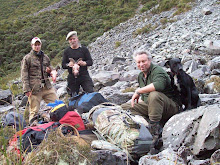
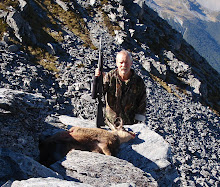
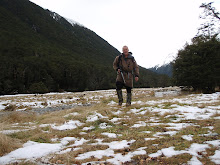


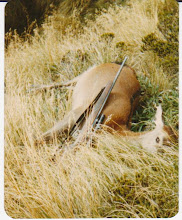






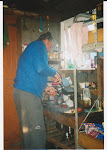

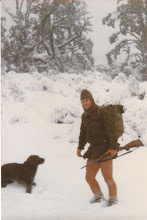
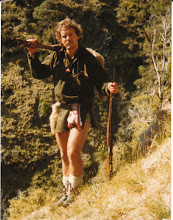



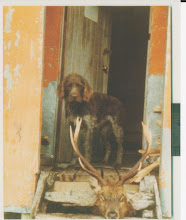
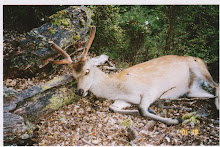

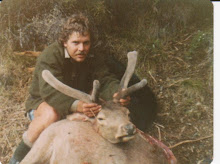


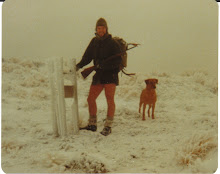
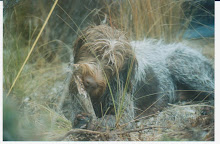


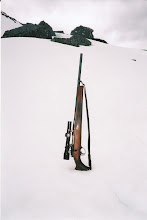
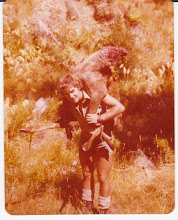
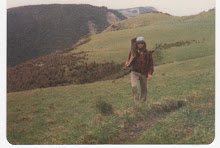

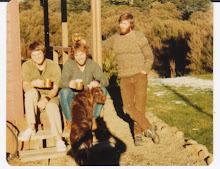
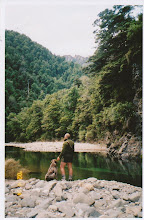
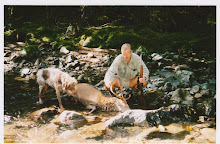

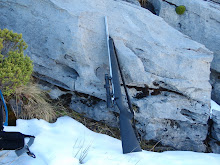


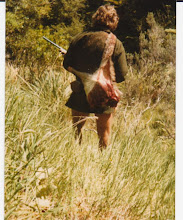
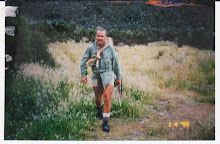

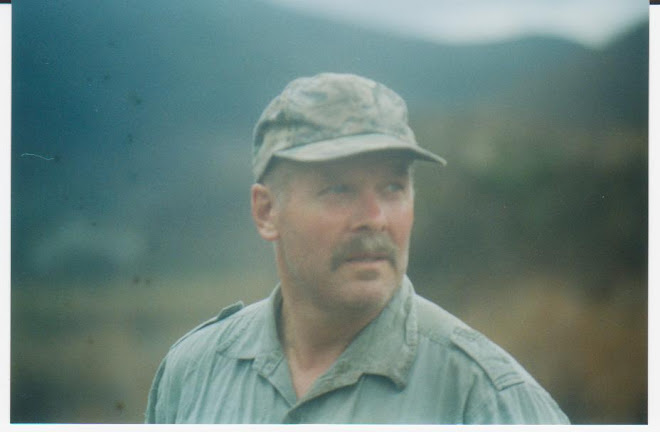
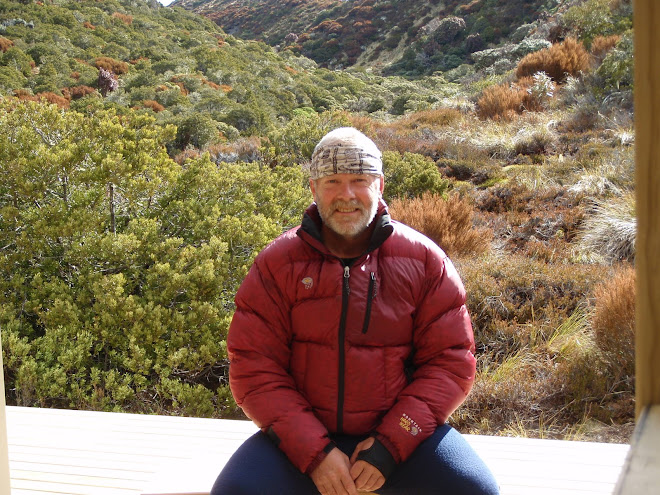


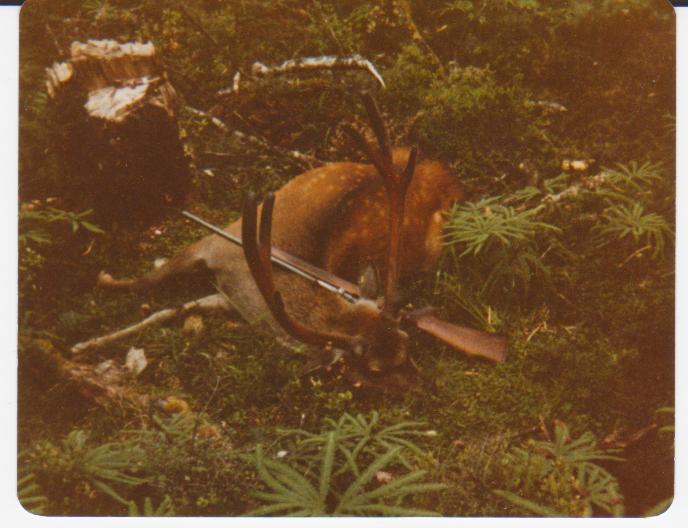
No comments:
Post a Comment